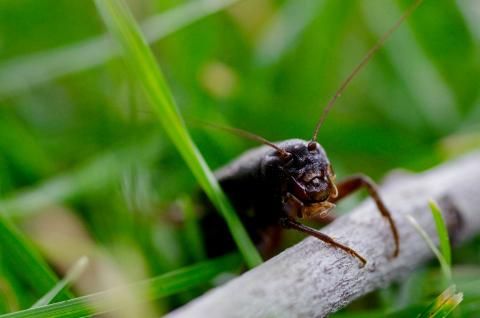
Crickets in Hawaii have started purring like cats—a case of evolution in action.
Researchers discovered males of the Pacific field cricket have "a newly evolved song" that is different from all other species. The song was also found to be a bit of an acoustic mess, with different crickets making different sounds. This indicates the song has not yet been refined, evolutionary speaking.
Robin Tinghitella, an assistant biology professor at the University of Denver, discovered the purring crickets in May 2017 after collecting specimens from the Kalaupapa National Historic Site on Molokai. She had come to the island to study what effect traffic noise had on cricket communication. During her graduate studies, Tinghitella had been part of a team that discovered silent crickets living on other Hawaiian islands. Researchers concluded these crickets had evolved to become silent to protect them from a parasitoid fly that used their song to locate them.
When she heard a purring noise coming from the box of crickets she had collected, she was confused: "This is like if lions never had manes and they all suddenly got manes. Or if peacocks never had tails with bright, colored plumes all over them and then suddenly had giant tails," she said in a statement.
Tinghitella and colleagues spent the next year studying the purring crickets and have now published their findings in the journal American Naturalist. They say the song of the Pacific field cricket (Teleogryllus oceanicus) is unlike any other known species. Researchers conclude the purring is used by males to attract females, and it appears to be a recently acquired skill.
"This is absolutely a case of evolution in action and we're excited to follow the evolution of the purring songs and to relate that change to which components of the new songs are detectable and attractive to female crickets," she told Newsweek. "The future evolution of purring songs might also be influenced by a parasitoid fly that is found in Hawaii. We know the fly is attracted to typical Pacific field cricket songs. If the fly can hear purring crickets too it might also shape future evolution in these new songs."

The team believes the purring crickets might have evolved from silent crickets. The mutation for purring might help them find mates, while remaining hidden from predators. "Our discovery of purring male crickets is an unprecedented opportunity to watch the emergence of a newly evolved sexual signal unfold in real time and has potential to illuminate the mechanisms by which evolutionary novelties arise and coevolve between the sexes," they conclude.
Tinghitella added: "It's possible that purring results from a relatively simple mutation or mutations similar to those that produce flatwings. And the flatwing mutation spread through the population in fewer than 20 generations over three to four years. So, evolution certainly can happen quickly in these crickets. As for refining the songs, though, that will likely depend on things like the how stringent female hearing and preferences are, whether the preferences of female crickets and flies match or not, the genetic architecture of the new trait and a whole other suite of things that we just don't know yet."
Speaking to New Scientist, Ann Hedrick, from the University of California Davis, who was not involved in the study, said the findings are "convincing. I definitely think it is plausible the purring crickets can communicate with potential mates," she said.
Tinghitella and her team hopes to continue to study the purring crickets—they have the opportunity to track "the very earliest stages of co-evolution,"she explained. "It's a really unprecedented opportunity and we'll be spending a lot of time in Hawaii figuring out how the signal functions in the field."
This story has been updated to include quotes from Robin Tinghitella.
Uncommon Knowledge
Newsweek is committed to challenging conventional wisdom and finding connections in the search for common ground.
Newsweek is committed to challenging conventional wisdom and finding connections in the search for common ground.
About the writer
Hannah Osborne is Nesweek's Science Editor, based in London, UK. Hannah joined Newsweek in 2017 from IBTimes UK. She is ... Read more
To read how Newsweek uses AI as a newsroom tool, Click here.








